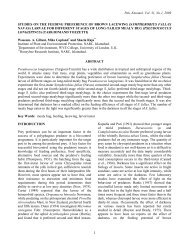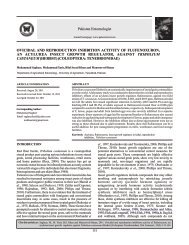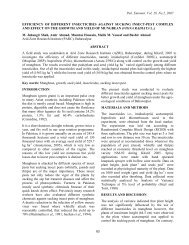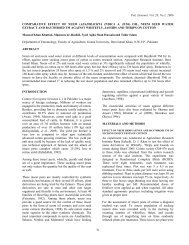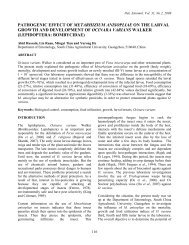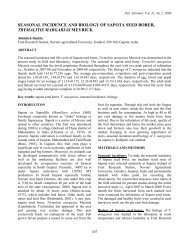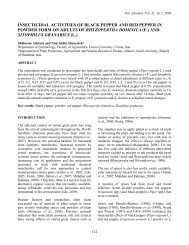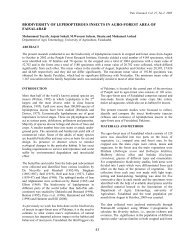(peganum harmala l.), rhizomes of kuth
(peganum harmala l.), rhizomes of kuth
(peganum harmala l.), rhizomes of kuth
Create successful ePaper yourself
Turn your PDF publications into a flip-book with our unique Google optimized e-Paper software.
Pak. Entomol. Vol. 28, No.1, 2006<br />
EFFECT OF DIFFERENT EXTRACTS OF HARMAL (PEGANUM HARMALA L.), RHIZOMES OF<br />
KUTH (SAUSSUREA LAPPA C. B. CLARKE) AND BALCHAR (VALARIANA OFFICIANALIS L.) ON<br />
THE SETTLING AND GROWTH OF PEACH FRUIT FLY, (BACTROCERA ZONATA SAUNDERS)<br />
Masood Khan Khattak 1 , Mohammad Faisal Shahzad 1 and Ghulam Jilani 2<br />
1. Department <strong>of</strong> Entomology, Faculty <strong>of</strong> Agriculture, Gomal University, D.I. Khan.<br />
2. Integrated Pest Management Program, IPEP, NARC, Islamabad.<br />
ABSTRACT<br />
Repellent and growth inhibiting effect <strong>of</strong> the plants viz. harmal, Kuth and balcher each extracted in petroleum ether,<br />
acetone and ethanol were evaluated at 2%, 1% and 0.5% concentrations against Bactocera zonata Saunder. In a free<br />
choice test in cages, none <strong>of</strong> the plant at 2% affected the settling <strong>of</strong> the test insect, however, emergence <strong>of</strong> progeny adult<br />
was significantly lower in petroleum, ether and acetone extract <strong>of</strong> Saussurea lappa and ethanol extract <strong>of</strong> Peganum<br />
<strong>harmala</strong>. Significantly, lower number <strong>of</strong> fruit flies settled on guava treated with 1% extract <strong>of</strong> all the tested plants as<br />
compared to that in the control. Pupal formation and emergence <strong>of</strong> progeny adult was totally inhibited in 1% petroleum<br />
extract <strong>of</strong> Saussurea lappa at 0.1%, number <strong>of</strong> adult settled were significantly lower in petroleum ether and acetone<br />
extract <strong>of</strong> P. <strong>harmala</strong> and S. lappa, respectively. However, adult emergence was significantly lower than control in all the<br />
extracts.<br />
INTRODUCTION<br />
Fruit fly, Bactrocera zonata Saund. (Diptera,<br />
Tephritidae) is a major insect pest <strong>of</strong> fruit and<br />
vegetables not only in Pakistan but the world over as<br />
well. Fruit fly cause 25-50% loss to guava during<br />
summer (Syed, 1970). The different species <strong>of</strong> fruit<br />
fly cause colossal losses to fruit and vegetables in<br />
tropical, sub tropical and temperate regions <strong>of</strong> the<br />
world (Batman, 1972). They cause direct loss to fruit<br />
and vegetables and indirect loss by enhancing<br />
expenditure on chemicals which alternately reduce<br />
the market value <strong>of</strong> the product. The infestation may<br />
reach up to 50% in summer crop <strong>of</strong> guava in<br />
Pakistan. The peaches, apricot, guava or other fruit<br />
attacked by this pest are malformed, mis-shaped,<br />
undersized and rotted inside. The damage caused is<br />
very heavy and the fruits become unmarketable<br />
(Atwal, 1976). Due to its life cycle, the actual<br />
damage is virtually safe from the insecticide<br />
applications as the eggs are laid in the fruit tissues<br />
and the larvae feed inside on the pulp. Therefore,<br />
control measures are to be directed at the adult flies.<br />
The adults are long lived and quite mobile but their<br />
longevity associated with frequent feeding enables<br />
them exposed to the poison baits and other control<br />
strategies. The enormous loss due to fruit flies in<br />
food production at all level <strong>of</strong> society demand to<br />
solve this problem with the implementation <strong>of</strong> wide<br />
management strategies in the area.<br />
Mostly, these insect pests are controlled by synthetic<br />
insecticides for their quick knock down effect,<br />
however, careless and indiscriminate use <strong>of</strong> these<br />
chemicals leads to a number <strong>of</strong> well known problems<br />
like contamination <strong>of</strong> food, soil, ground water, lakes,<br />
rivers, oceans, air with toxic residues which carry side<br />
effects on non target insects and other organisms,<br />
development <strong>of</strong> resistance in insects against these<br />
pesticides and pest resurgence etc. In addition, many non<br />
lethal and lethal accidents occur due to mishandling <strong>of</strong><br />
highly toxic synthetic products. Because <strong>of</strong> these hazards<br />
<strong>of</strong> the chemicals, there is growing awareness in developed<br />
and even in developing countries <strong>of</strong> toxicological and<br />
environmental problems involved in the use <strong>of</strong> synthetic<br />
pesticides. This awareness has lead to a steadily increasing<br />
movement toward more environmental oriented,<br />
sustainable agriculture with low or no input <strong>of</strong> toxic<br />
synthetic material and other agriculture chemicals in an<br />
attempt to preserve and protect the environment and as<br />
well as human health.<br />
Plant kingdom is by far the most efficient factory <strong>of</strong><br />
compounds. Plants synthesize countless products which<br />
can partially be considered as weapon to defend plants<br />
against pests and diseases. Plants derivatives are less toxic<br />
or non toxic to mammals and other vertebrates and<br />
invertebrates. Plant products have several uses in insect<br />
control. Some act as attractants like geranil and eugenol<br />
while some act as repellent, deterrent and antiovipositional<br />
like neem oil and cotton seed oil etc. The<br />
primary role, however, is insect toxicants (Hashimi, 2001).<br />
Out <strong>of</strong> 2600 plant species in the insect pests control<br />
potential, pyrethrum, nicotine, rotenone, ryania, sabadilla<br />
and neem have been registered for significant use as<br />
insecticides (Dhaliwal and Heinrich, 1998).<br />
Different formulations prepared from neem and other<br />
plants like, Pongamina, datura, thevatia etc. have proved<br />
promising in checking insect pest population. The most<br />
important aspect in the use <strong>of</strong> plant products against insect<br />
15
Pak. Entomol. Vol. 28, No.1, 2006<br />
pest is that these naturally occuring materials are non<br />
toxic to man and other animals and are environment<br />
friendly.<br />
METHODS AND MATERIALS<br />
Settling and Growth Regulating Effects <strong>of</strong> Certain<br />
Plants Extracts<br />
To test the repellent/deterrent and growth inhibiting<br />
effects <strong>of</strong> certain plants extracts against peach fruit<br />
fly, Bactrocera zonata (Saunder), studies were<br />
carried out at Insect Pest Management Program<br />
(IPMP), Institute <strong>of</strong> Plant and Environmental<br />
Protection, National Agriculture Research Center,<br />
Islamabad.<br />
Seed <strong>of</strong> Harmal (Peganum <strong>harmala</strong> L.), Rhizomes <strong>of</strong><br />
<strong>kuth</strong> (Saussurea lappa C.B.Clarke) and Balchar<br />
(Valariana <strong>of</strong>ficianalis L.) used in these studies were<br />
received from the Agervedec shop in Rawalpindi.<br />
Peach fruit fly (Bactrocera zonata) used in these<br />
studies were obtained from the culture maintained in<br />
the laboratory with 27±1C 0 , 60±5% relative humidity<br />
and 14:10 light and dark. Fruit flies were reared on<br />
artificial diet in fruit fly rearing cage (18 x 16 x 16)<br />
having muslin cloth on the two opposite sides. The<br />
other two sides top and bottom were made <strong>of</strong><br />
transparent glass sheet. On alternate day, fresh fruits<br />
were <strong>of</strong>fered to adult flies for oviposition. After<br />
infestation, these fruits were placed in glass jars<br />
having sand at the base for pupation. To allow<br />
aeration the jars were covered with muslin cloth. The<br />
pupae were separated from the sand with 20m sieve.<br />
Pupae were placed in rearing cage with cotton soaked<br />
in water to prevent dessication. After emergence <strong>of</strong><br />
flies, pertinacious diet was provided on daily basis to<br />
the flies. For water requirements water soaked cotton<br />
was placed in Petri-dish inside the rearing cage.<br />
Artificial diet for fruit flies<br />
Ingredient<br />
Bananas<br />
Egg yolk<br />
Honey<br />
Lederplex vitamin B. Complex syrup<br />
Yeast<br />
Sugar<br />
quantity<br />
2 No<br />
6 No<br />
4 table spoon<br />
2 table spoon<br />
1 table spoon<br />
8 table spoon<br />
The ingredients were mixed in a blender to make a<br />
thick syrup solution. For further use the diet is kept in<br />
refrigerator. Products <strong>of</strong> all the tested three plants<br />
were separated, ground to fine powder <strong>of</strong> 60 mesh.<br />
The plant powder were separated, extracted with<br />
petroleum ether, acetone and ethanol in Soxhlet<br />
extraction apparatus, concentrated in rotary<br />
evaporator and finally made solvent free in a vacuum<br />
dessicator. Since plant extracts are insoluble in water<br />
therefore, a small quantity <strong>of</strong> detergent (Surfactant) was<br />
added in distilled water.<br />
To see the effect <strong>of</strong> test plants extracts on the settling <strong>of</strong><br />
fruit flies. All the plant extracts were applied at 2%, 1%<br />
and 0.5% to the fruits separately by dipping method. The<br />
treated and untreated fruits were placed randomly in the<br />
rearing cages. Fifteen day old 40 female fruit flies were<br />
released in the cage. Each cage providing free choice was<br />
replicated three times. The number <strong>of</strong> fruit flies adults<br />
settled on treated and untreated fruits were counted after<br />
every two hours for two days. In this way the repellency/<br />
deterrence was counted. After 48 hours the exposed treated<br />
and untreated fruit to fruit flies were removed and placed<br />
in separate plastic jars with sand in it for fruit flies<br />
pupation. The jars were covered with muslin cloth and<br />
properly labeled. Each treatment was replicated three<br />
times. After 20 days the sand was sieved with 20 mesh<br />
sieve. The pupae were separated and counted and data<br />
recorded for each treatment. The pupae were sticked to<br />
glass vials. The vials were covered with muslin cloth and<br />
labeled. Cotton soaked in water were placed at the top <strong>of</strong><br />
vials to provide moisture needed to prevent pupal<br />
dessication. The emergence <strong>of</strong> fruit fly adults were<br />
recorded for each treatment.<br />
RESULTS<br />
Petroleum ether, acetone and ethanol extract <strong>of</strong> P.<br />
<strong>harmala</strong>, V. <strong>of</strong>ficianalis, and S. lappa when applied at 2%<br />
to guava fruits did not significantly affected the settling or<br />
non preference response <strong>of</strong> the fruit flies (Table-1); as the<br />
mean number <strong>of</strong> flies settled on fruit treated with different<br />
extracts <strong>of</strong> plants at 2% concentration were statistically<br />
similar to those settled on the untreated guava fruit.<br />
However, as compared to 0.6867 adults in the control, the<br />
lowest number <strong>of</strong> fruit flies adults settled on guava fruits<br />
treated with 2% acetone extract <strong>of</strong> V. <strong>of</strong>ficianalis. This was<br />
followed by 0.2633 and 0.3733 flies in 2% petroleum ether<br />
extract <strong>of</strong> S. lappa and 0.3967 adult ethanol extract <strong>of</strong> V.<br />
<strong>of</strong>ficianalis.<br />
When the same exposed fruits were placed separately for<br />
pupation the number <strong>of</strong> pupae in some treatments were<br />
significantly lower than those in the control (Table-2).<br />
Minimum number (2.667) pupae were counted each from<br />
the fruits treated with ethanol extract <strong>of</strong> P. <strong>harmala</strong> and<br />
petroleum ether <strong>of</strong> S. lappa followed by 3.00 from those<br />
treated with acetone extract <strong>of</strong> S. lappa. These number<br />
were statistically lower than 11.33 pupae in the control.<br />
The fruits treated with petroleum ether extract <strong>of</strong> P.<br />
<strong>harmala</strong> had 7.00 pupae, which were still significantly<br />
lower than those in the control but not from the remaining<br />
treatments. (Table-2). The trend <strong>of</strong> adult emergence was<br />
similar to that <strong>of</strong> pupae. Minimum and significantly lower<br />
16
Pak. Entomol. Vol. 28, No.1, 2006<br />
number <strong>of</strong> adult emerged at the same treatment in<br />
which pupae were minimum and significantly lower<br />
than other treatments and control.<br />
Settling response by B. zonata on guava fruits treated<br />
with 0.5% concentration <strong>of</strong> petroleum ether, acetone<br />
and ethanol extracts <strong>of</strong> P. <strong>harmala</strong>, V. <strong>of</strong>ficianalis<br />
and S. lappa in a free choice test is given in Table-3.<br />
It reveled that flies settled on fruits treated with 0.5%<br />
Petroleum ether extract <strong>of</strong> P. <strong>harmala</strong> and Petroleum<br />
ether extracts. In these treatments only 0.1300 and<br />
0.0767 flies settled on the treated fruits which were<br />
statistically lower than the 0.8467 flies settled on the<br />
untreated fruits. In other treatment, though, lower<br />
number <strong>of</strong> flies settled on the treated fruits were not<br />
statistically different to that on the untreated one.<br />
The number <strong>of</strong> pupae recovered in all these<br />
treatments were significantly lower than the pupae<br />
obtained in the control except for the pupae<br />
recovered from fruits treated with acetone extract <strong>of</strong><br />
P. <strong>harmala</strong>. The lowest number (1.667) pupae were<br />
obtained from the fruits treated with acetone extract<br />
<strong>of</strong> S. lappa, however, were statistically similar to the<br />
pupae recovered in the other treatments except<br />
control. Almost, similar trend was observed in the<br />
adult emergence. Significantly lower number <strong>of</strong><br />
adults emergence in all treatments as compared to<br />
those in the control.<br />
The above results showed that there was no<br />
correlation between the number <strong>of</strong> adult flies settled<br />
and progeny recovered. This phenomenon clearly<br />
indicate that some <strong>of</strong> the treatments affected both<br />
settling as well as egg laying response while others,<br />
were partially effective. Extracts <strong>of</strong> the tested plants,<br />
when applied at 1% to guava fruits, significantly<br />
reduced the settling <strong>of</strong> fruit fly on treated fruits as<br />
compared to the untreated ones. However, fruit fly<br />
adults settled on the treated fruits with different<br />
extracts were statistically similar to each other<br />
(Table-3). Petroleum ether extract <strong>of</strong> V. <strong>of</strong>ficianalis<br />
with 0.2233 adults ranked first in showing non<br />
preference by test insect followed by 0.2467, 0.2867<br />
and 0.3500 adults on guava fruits treated with 1%<br />
ethanol extract <strong>of</strong> P. <strong>harmala</strong>, acetone extracts <strong>of</strong> P.<br />
<strong>harmala</strong>, ethanol extract <strong>of</strong> V. <strong>of</strong>ficianalis and<br />
petroleum ether extract <strong>of</strong> P. <strong>harmala</strong>, respectively.<br />
When the fruits used in this study were keep<br />
separately in jars with sand at their bottom,<br />
statistically similar pupae were recovered in all<br />
treatments as compared to those in the control except<br />
<strong>of</strong> S. lappa where no pupae were recovered. Hence,<br />
when there were no pupae, therefore, were no adult<br />
recovery, though the number <strong>of</strong> flies settled on these<br />
fruits were statistically similar to those on the other<br />
treatments.<br />
Table-1. Mean number <strong>of</strong> Bactrocera zonata settled and progeny recovered<br />
from untreated Guava fruits and those treated with 2% concentration <strong>of</strong><br />
petroleum ether, acetone, and ethanol extract <strong>of</strong> different plants in a free choice<br />
test<br />
Plant<br />
Mean Number <strong>of</strong><br />
Solvent 2% Adu. Settled Pupae Recovered Adu. Emerged<br />
Peganum <strong>harmala</strong><br />
Petroleum ether 0.5533 a 7.000 b 7.000 bc<br />
Acetone 0.4433 a 8.000 ab 7.000 bc<br />
Ethanol 0.4433 a 2.667 c 1.333 d<br />
Valariana <strong>of</strong>ficianalis<br />
Petroleum ether 0.5500 a 11.33 a 9.667 ab<br />
Acetone 0.2600 a 8.33 ab 6.333 c<br />
Ethanol 0.3967 a 10.33 ab 10.00 a<br />
Sassurea lappa<br />
Petroleum ether 0.2633 a 2.667 c 2.333 d<br />
Acetone 0.3733 a 3.000 c 2.000 d<br />
Ethanol 0.6633 a 9.000 ab 8.000 abc<br />
Control 0.6867 a 11.33 a 7.667a<br />
Each value is a mean <strong>of</strong> three replications, 10 pairs per replication. Mean<br />
values among the columns followed by the same letters are not significantly<br />
different at α = 0.05, having LSD value = 0.4912 for settling, LSD value = 3.695<br />
for pupae, & LSD value = 2.639 for adult<br />
Table-2. Mean number <strong>of</strong> Bactrocera zonata settled and progeny recovered<br />
from untreated Guava fruits and those treated with 1% concentration <strong>of</strong><br />
petroleum ether, acetone, and ethanol extract <strong>of</strong> different plants in a free choice<br />
test<br />
Plant<br />
Mean Number <strong>of</strong><br />
Solvent 2% Adu. Settled Pupae Recovered Adu. Emerged<br />
Peganum <strong>harmala</strong><br />
Petroleum ether 0.3500 b 3.667 abc 3.667 ab<br />
Acetone 0.2867 b 3.667 abc 2.333 ab<br />
Ethanol 0.2467 b 6.670 bc 1.000 ab<br />
Valariana <strong>of</strong>ficianalis<br />
Petroleum ether 0.2233 b 2.667 abc 2.333 ab<br />
Acetone 0.5167 b 8.000 abc 6.667 ab<br />
Ethanol 0.2867 b 4.000 abc 3.667 ab<br />
Sassurea lappa<br />
Petroleum ether 0.4367 b 0.000 c 0.0000 b<br />
Acetone 0.4333 b 3.667 abc 3.667 ab<br />
Ethanol 0.4333 b 10.33 a 8.000 a<br />
Control 1.0200 a 8.333 ab 7.667 a<br />
Each value is a mean <strong>of</strong> three replications, 10 pairs per replication. Mean<br />
values among the columns followed by the same letters are not significantly<br />
different at α = 0.05, having LSD value =0.3431 for settling, LSD value = 7.041<br />
for pupae, and LSD value = 6.127 for adult<br />
Table-3. Mean number <strong>of</strong> Bactrocera zonata settled and progeny recovered<br />
from untreated Guava fruits and those treated with 0.5% concentration <strong>of</strong><br />
petroleum ether, acetone, and ethanol extract <strong>of</strong> different plants in a free choice<br />
test<br />
Plant<br />
Mean Number <strong>of</strong><br />
Solvent 2% Adu. Settled Pupae Recovered Adu. Emerged<br />
Peganum <strong>harmala</strong><br />
Petroleum ether 0.1300 b 4.667 b 3.333 b<br />
Acetone 0.4900 ab 12.67 ab 10.33 b<br />
Ethanol 0.4633 ab 8.333 b 7.333 b<br />
Valariana <strong>of</strong>ficianalis<br />
Petroleum ether 0.433 ab 3.000 b 2.000 b<br />
Acetone 0.3567 ab 7.000 b 6.333 b<br />
Ethanol 0.3133 ab 3.333 b 2.333 b<br />
Sassurea lappa<br />
Petroleum ether 0.5133 ab 3.000 b 2.000 b<br />
Acetone 0.1767 b 1.667 b 0.000 b<br />
Ethanol 0.5567 ab 5.000 b 3.333 b<br />
Control 0.8467 a 23.00 a 22.00 a<br />
Each value is a mean <strong>of</strong> three replications, 10 pairs per replication. Mean<br />
values among the columns followed by the same letters are not significantly<br />
different at α = 0.05, having LSD value =0.5287 for settling, LSD value = 12.01<br />
for pupae, and LSD value = 9.910 for adult<br />
17
Pak. Entomol. Vol. 28, No.1, 2006<br />
DISCUSSION<br />
To reduce losses by fruit flies, farmers mostly use<br />
synthetic insecticides which cause serious social and<br />
environmental repercussions. Male Inhalation<br />
Technique (MIT), Bait Application Technique<br />
(BAT), sanitation <strong>of</strong> orchards are very effective and<br />
friendly management measures but are not adapted<br />
by the majority <strong>of</strong> farmers, therefore, it is felt that<br />
fruit flies can be effectively controlled only through<br />
integrated pest management using environmental<br />
friendly materials to replace insecticides.<br />
Among various plant extracts applied to guava fruit<br />
in the laboratory studies, Valariana <strong>of</strong>ficianalis<br />
extract in acetone and petroleum ether significantly<br />
repelled the fruit flies from the treated fruit.<br />
Petroleum ether and acetone extracts <strong>of</strong> Saussurea<br />
lappa although, was not effective in reducing the<br />
settling <strong>of</strong> flies on treated fruit, it significantly<br />
affected the pupal formation and adult emergence.<br />
This indicated that Saussurea lappa had suppressed<br />
egg laying. Chander (1999), Harish (2000) found that<br />
these plants oil significantly repelled major insect<br />
pests <strong>of</strong> stored grain and growth <strong>of</strong> certain stored<br />
grain insect pests was impaired . Neem seed kernel<br />
extracts worked as oviposition deterrent to<br />
Bactrocera curcurbitae and B. dorsalis on pumpkin<br />
and guava, respectively. The acetone extract <strong>of</strong> deoiled<br />
kernel powder significantly deterred oviposition<br />
by both species at 0.5% and 1.25% (Shivendra et al.,<br />
1998). Renden et al. (1998) investigated a strong<br />
negative effect <strong>of</strong> neem based insecticides on the<br />
oviposition, egg development and survival <strong>of</strong> the<br />
adults.<br />
In the present studies, the tested plant derivatives<br />
significantly affected the growth <strong>of</strong> fruit flies.<br />
Similar, results were obtained by Hassan (1998),<br />
according to him, neem seed kernel extract (NSKE)<br />
negatively affected the 1 st and 2 nd instar larvae <strong>of</strong> the<br />
Queensland fruit fly on persimmon. A high<br />
proportion <strong>of</strong> adults emerging from the treated pupae<br />
showed wing deformation preventing them from<br />
flying. Shakunthala et al. (2001) demonstrated<br />
remarkable changes in the size and morphology <strong>of</strong><br />
the reproductive organs <strong>of</strong> adult flies when Acorus<br />
calamus extract were used against B. cucurbitae.<br />
10% ether extract <strong>of</strong> Peganum <strong>harmala</strong> significantly<br />
increased adult mortality, retarded rate <strong>of</strong><br />
development, reduced adult emergence <strong>of</strong><br />
Callosobruchus chinensis.<br />
Some botanicals are also used as attractants for fruit<br />
flies. Kardinam (1999) found that Melaleuca<br />
bracteala oil containing methyl eugenol was effective in<br />
trapping fruit flies. Shivendra et al. (2001) tested five<br />
fractions <strong>of</strong> Acorus calamus oil against Bactrocera<br />
cucurbitae and B. dorsalis. Fl fractions were attractive to<br />
male Bactrocera dorsalis. FII (acoragermacrone) was<br />
more attractive to female flies.<br />
LITERATURE CITED<br />
Atwal, A.S., 1976. Agricultural pests <strong>of</strong> India & Southeast<br />
Asia, Kalyani Publishers, New Delhi.<br />
Bateman, M.A., 1972. The ecology <strong>of</strong> fruit flies, Ann. Rev.<br />
Ent., 17: 493-518.<br />
Chander, H., 1999. Laboratory evaluation <strong>of</strong> plant extracts as<br />
repellent to the rust flour beetle, Tribolium<br />
castaneum on jute fabric, Internat. Pest Contr., 41<br />
(1): 18-20.<br />
Dhaliwal, G.S. and R.A. Heinrich, 1998. Critical Issues in<br />
insect management. Common wealth publishers,<br />
New Delhi.<br />
Harish, C., 2000. Repellency <strong>of</strong> different plant extracts and<br />
commercial formulations used as prophylactic spray<br />
to protect bagged grain against Tribolium<br />
castaneum, J. Food. Sci., and Techa. Mysore. 6(37):<br />
582-585.<br />
Hashmi, A.A., 2001. Integrated pest management in the 21 st<br />
century, PARC publication, Islamabad.<br />
Hassan, E., 1998. Insecticidal toxicity <strong>of</strong> neem seed kernel<br />
extract (NSKE) on Bactrocera tryoni (Frogg.)<br />
(Diptera: Tephritidae) and repellency on persimmon<br />
fruit. Zeitschrift-fur-Pflanzenkrankheiten-und-<br />
Pflanzenschutz. 105 (4): 411-416.<br />
Kardinan, A., 1999. Prospect <strong>of</strong> Melaleuca bracteata leaf oil<br />
as fruit fly Bactrocera dorsalis control in Indonesia,<br />
Journal Penelitian and Pengembangan Pertanian.,<br />
18(1): 10-17.<br />
Renden, E.J., B.D. Roitberg and E.J. Randen, 1998. Effect <strong>of</strong><br />
a neem Azadirachta india based insecticide on<br />
oviposition deterrence, survival, behavior and<br />
reproduction <strong>of</strong> adult western cherry fruit fly<br />
(Diptera: Tephritidae), J. Eco. Ent., 91(1): 123-130.<br />
Shakunthala, N. and J. Thomas, 2001. Ovipositior deterrence<br />
<strong>of</strong> Acorus calamus L. on melon flu, Bactrocera<br />
cucurbitae, Insect Environm., 39(2): 145-148.<br />
Shivendra, S. and R.P. Singh, 1998. Neem Azadirachta indica<br />
seed kernel extracts and azadirachtin as oviposition<br />
deterrents against the melon fly Bactrocera<br />
cucurbitae and the oriental fruit fly Bactrocera<br />
dorsalis. Phytoparasitica, 26(3): 191-197.<br />
Shivendra, S., S.S. Sehgal and S. Singh, 2001. Investigations<br />
on constituents <strong>of</strong> Acorus calamus root oil as<br />
attractants to melonfly, Bactrocera cucurbitae and<br />
oriental fruit fly, Bactrocera dorsalis. Indian J. Ent.,<br />
63(3): 340-344.<br />
Syed, R.A., 1970. Studies on the trypetids and their natural<br />
enemies in West Pakistan. Dacus spp. <strong>of</strong> lesser<br />
importance, Pak. J. Zool., 2: 17-24.<br />
18



